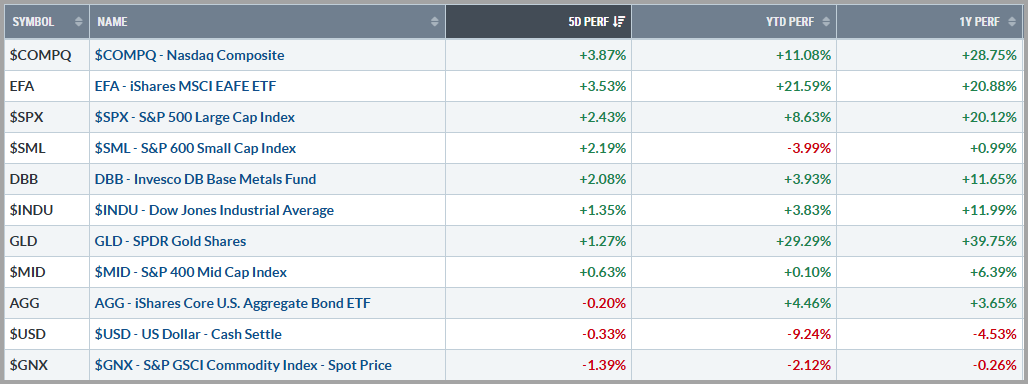Weekly Market Recap: Resilience Amid Concern
The market’s resilience last week was nothing short of remarkable and perhaps a bit puzzling. Investors brushed aside two pieces of economic news that would normally send them running for cover: a dismal July jobs report and a gloomy ISM Services release hinting at the dreaded one-two punch of slow growth and rising prices. Many would call it a stagflation double‑whammy, where growth stalls but inflation refuses to cool. July saw just 73,000 new jobs (far below forecasts), while May and June jobs figures were revised sharply lower. At the same time, the ISM Services PMI barely clung to positive territory, and its “prices paid” index reading jumped to the highest since October 2022, a classic sign of sticky inflation. Yet instead of fleeing, investors sent the S&P 500 up nearly 2.5% for the week.
What’s fueling this upbeat mood? Beyond calming headlines on tariff talks and Apple’s massive new U.S. tech investment, the real sugar rush is coming from some expectations that the Federal Reserve will cut interest rates as soon as September. Several market indicators suggest the odds of a September cut have surged above 90%, with analysts betting softer data will push the Fed toward a 0.25% trim at its next meeting. Rate cuts have always been music to investors’ ears, but the underlying economic signals still call for some caution. Commodities told their own story: oil slid to two-month lows, gold prices raced to fresh record highs on safe-haven demand, while copper, along with the other industrial metals, mostly treaded water as they are seemingly still digesting July’s sharp selloff. In macro markets, 10-year Treasury yields edged up toward 4.3%, as traders apparently absorbed stagflationary data and Treasury auctions, while the U.S. dollar softened on rising bets for a cut.
When all was said and done, equity markets shrugged off some rather gloomy data, lifted by rate cut hopes, clearer tariff waters, and hints of easing geopolitical tension, while the commodities complex served as a reminder that the road ahead will require a careful balance between optimism and caution.

Source: stockcharts.com
On Deck this week: Inflation and Spending
This week is important one with key inflation and consumer spending data on deck.
The most important report is tomorrow’s Consumer Price Index (CPI). If inflation comes in hotter than expected, September rate cut hopes could drop sharply. Since rate cut expectations have helped fuel recent stock gains, a hot CPI may pressure markets.
On the growth side, Friday’s retail sales report is the main event. Consumer spending drives the U.S. economy, and so far in 2025 retail sales have been resilient. But with tariffs in place and early buying ahead of them now past, this report may reveal whether spending is slowing.
Other notable reports this week include Producer Price Index (PPI) and the often volatile Empire Manufacturing Survey.
The best outcome for stocks may be mild inflation combined with stronger-than-expected growth data, which could ease stagflation fears.
Big Picture in Simple Terms: A Cautious Optimism Amid New Labor Market Concerns
Markets have enjoyed a summer wave of optimism, with major indexes hitting fresh record highs. Investors seemingly remain encouraged by resilient consumer spending, solid corporate profits, and growing speculation that the Federal Reserve might begin cutting interest rates before year-end.
Still, it may be wise to enjoy the celebration without getting too comfortable just yet. While inflation is broadly contained, certain areas, including those impacted by tariffs, are seeing persistent price pressures that could slow growth. Furthermore, recent data highlight emerging concerns: hiring has noticeably cooled down, with the labor market showing signs of fatigue after a prolonged tight phase. This slowdown in hiring could be feeding into cautious household budgets and weakening retail sales momentum. Consumer confidence and housing market activity have also plateaued or softened, signaling that some of the economic engines may be losing steam.
Critically, new labor market dynamics are adding complexity and uncertainty lingers around the Fed’s next moves amid these mixed signals. While hopes for a rate cut later this year remain alive, the Fed’s cautious language has seemed to suggest they’re not in a hurry to bring rates down. Trade policy uncertainties continue to cloud the outlook as well, contributing to a backdrop where the economy appears to be in the late stages of the business cycle; a phase that has historically been marked by a delicate balance of risks and rewards.
In sum, the market’s current optimism is supported by broad strength, but tempered by emerging signs of slower growth and tricky labor market developments. Enjoy the good times, but keep a watchful eye. History reminds us that markets can quickly change course, especially when optimism runs very high.
Please feel free to share these commentaries and, should you have any questions regarding your current strategy or the markets in general, please reach out to your CIAS Investment Adviser Representative.
Important Disclosures:
Past performance is not indicative of future results. This material is not financial advice or an offer to sell any product. The statements contained herein are solely based upon the opinions of Edward J. Sabo and the data available at the time of publication of this report, and there is no assurance that any predicted or implied results will actually occur. Information was obtained from third-party sources, which are believed to be reliable, but are not guaranteed as to their accuracy or completeness.
The actual characteristics with respect to any particular client account will vary based on a number of factors including but not limited to: (i) the size of the account; (ii) investment restrictions applicable to the account, if any; and (iii) market exigencies at the time of investment. Capital Investment Advisory Services, LLC (CIAS) reserves the right to modify its current investment strategies and techniques based on changing market dynamics or client needs. The information provided in this report should not be considered a recommendation to purchase or sell any particular security. There is no assurance that any securities discussed herein will remain in an account’s portfolio at the time you receive this report or that securities sold have not been repurchased. The securities discussed may not represent an account’s entire portfolio and in the aggregate may represent only a small percentage of an account’s portfolio holdings. It should not be assumed that any of the securities transactions, holdings or sectors discussed were or will prove to be profitable, or that the investment recommendations or decisions we make in the future will be profitable or will equal the investment performance of the securities discussed herein.
CIAS is a registered investment advisor. More information about the advisor, including its investment strategies and objectives, can be obtained by visiting www.capital-invest.com. A copy of CIAS’s disclosure statement (Part 2 of Form ADV) is available, without charge, upon request. Our Form ADV contains information regarding our Firm’s business practices and the backgrounds of our key personnel. Please contact us at (919) 831-2370 if you would like to receive this information.
Capital Investment Advisory Services, LLC
100 E. Six Forks Road, Ste. 200; Raleigh, North Carolina 27609
Securities offered through Capital Investment Group, Inc. & Capital Investment Brokerage, Inc.

